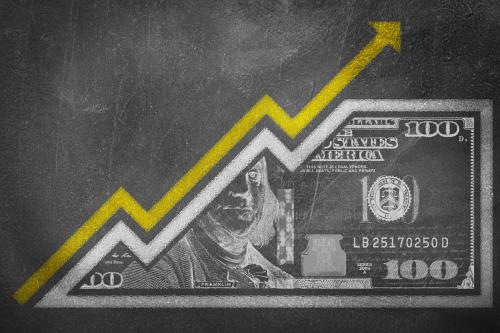This blog is a summary of a conversation between David Wessel, Wendy Edelberg, Justin Wolfers, and Neil Irwin on March 10, 2022. Listen to the discussion at the bottom of this post and read the transcript here.
The Bureau of Labor Statistics (BLS) this week reported that the Consumer Price Index (CPI), the most widely used measure of inflation, rose 0.8% in February, up 7.9% over the last twelve months. That rate is as high as its been in 40 years.
Just after the BLS release, The Brookings Institution gathered a host of experts to explain what the latest CPI report tells us about the current state and near future of the economy on a Twitter Spaces discussion.
What’s driving inflation?
A large component of the increase in inflation was the cost of energy, which had already begun to go up in the weeks preceding the current war in Ukraine, said Neil Irwin, Chief Economic Correspondent for Axios. But even taking out energy and food, core inflation was at a 6.4% increase year over year – still far above the Federal Reserve’s 2% inflation target, Irwin noted.
“[These are] certainly the kinds of numbers that suggest that inflation remains a major problem in the U.S. economy,” Irwin told David Wessel, director of the Hutchins Center on Fiscal and Monetary Policy.
Wendy Edelberg, director of the Hamilton Project, also noted core goods’ impact. Approximately two-thirds of the increase in inflation the last six months had been due to goods, she said, the result of an “off-the-charts” surge in consumer demand and lagging supply – both pandemic-related factors that Edelberg explored in a recent blog.
Uncertainty ahead
Looking ahead, Edelberg says consumer demand will inevitably pivot from demand for goods to demanding for services as the pandemic recedes, and so inflation in the future will depend much more significantly on the service sector: “If the service sector sees a big burst of demand but can’t keep up there, that will be because they can’t find the workers, and they will pass on that wage pressure into prices.”
“[These are] certainly the kinds of numbers that suggest that inflation remains a major problem in the U.S. economy,”
While Edelberg noted that real wages have gone up for some low-wage workers, wage increases have not generally kept pace with inflation, at least so far. “There’s no question that headline inflation is running faster than wages,” said Justin Wolfers, University of Michigan professor of public policy and economics and Brookings nonresident senior fellow.
Wages will almost certainly catch up with inflation, said Wolfers, but when that will happen is uncertain. “It may not be very comforting for people to hear right now, that their cost of living is rising faster than their wages, but I think there’s good reason to be confident that wages are going to catch up. The question is how long will that take.”
Unknowns on the global stage also factor into the inflation equation, with the war in Ukraine likely to constrain the supply of raw goods, from wheat to palladium. “There’s reason to think that this entire crisis in Eastern Europe is really going to have ripples through the entire world economy and U.S. supply chains that we don’t fully understand yet and don’t know quite how severe they’ll end up being,” said Irwin.
Managing inflation and inflation expectations
Another concern is that the highest inflation rate in a generation could lead to increased inflation expectations, which could create a vicious cycle of higher expectations creating even higher inflation, as Justin Wolfers explained. Wolfers noted that people’s thinking about inflation would likely be shaped by their experiences, with those who lived through high inflation of the 1970s much more concerned about its return.
Outside of the very visible prices that are going up – gas and groceries, for example – housing prices are a longer-term concern. “Actually gas and groceries aren’t the majority of the budget for most people,” said Wolfers. The biggest expenses are things like health insurance and housing – “they’re the silent killers,” Wolfers continued. With the recent rise in housing prices, so too will rents rise. “This is going to be something that’s going to weigh on the CPI, and not just this year but over the next few years,” said Wolfers.
“The arc is I think going to follow consumer demand, and consumer demand is going to come down.”
To confront high inflation, the Federal Reserve, which took unprecedented steps to protect the economy early in the pandemic, has already signaled that it will likely raise interest rates several times this year. “It’s not that they’re trying to create tight monetary policy,” said Edelberg, “it’s that they’re trying to create less loose monetary policy,” an effort that Wessel likened to taking a foot off the gas but not yet putting it on the brake. The Fed’s goal, said Edelberg, will be to temper demand for goods in the economy, an effort that will be naturally aided by higher energy prices.
Although inflation now seems less temporary than it did a few months ago, Edelberg says she still sees an arc in its trajectory, rather than a plateau: “The arc is I think going to follow consumer demand, and consumer demand is going to come down. And so I don’t see this just being a permanent part of our economy forevermore.”
Listen to the full discussion, which also included analysis of the federal budget impact and a full explanation of inflation expectations, below or read the transcript here.
The Brookings Institution is financed through the support of a diverse array of foundations, corporations, governments, individuals, as well as an endowment. A list of donors can be found in our annual reports published online here. The findings, interpretations, and conclusions in this report are solely those of its author(s) and are not influenced by any donation.







Commentary
Inflation in America: Experts react to the latest CPI release
March 11, 2022